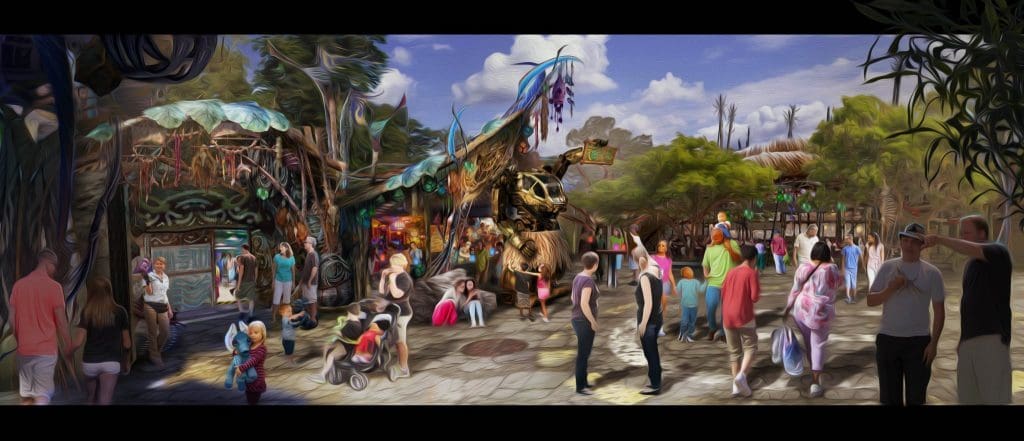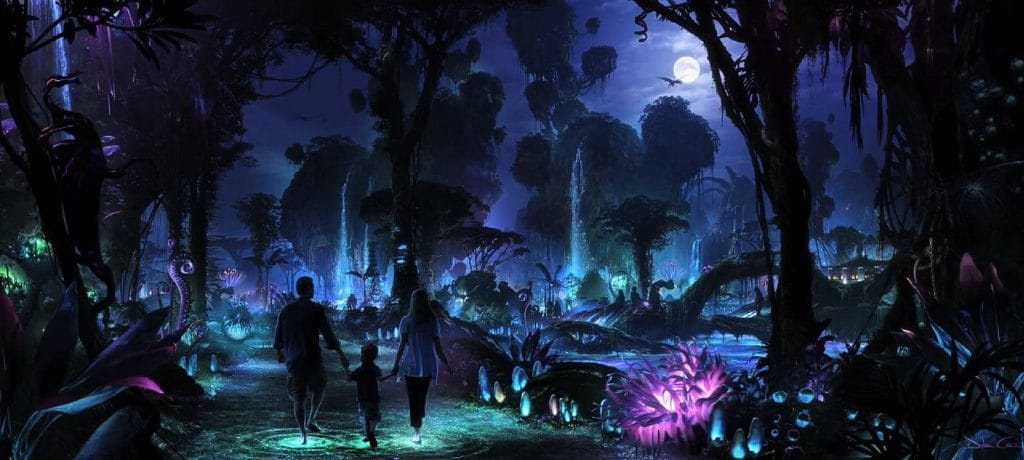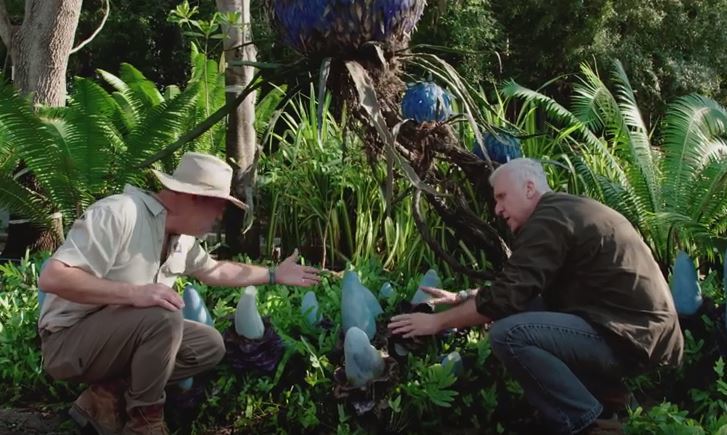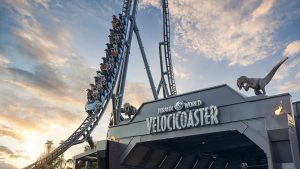There’s been so much hype for this summer’s Pandora: The World of Avatar – most of it from Disney’s Imagineers and Avatar’s filmmakers themselves – that it seems almost impossible for it to live up to even half of the built-up expectations. Then again, the very same scenario greeted Universal’s The Wizarding World of Harry Potter – Diagon Alley three years ago, and that theme park land still managed to go down in the history books as one of, if not the, best themed areas in the entire world. This means Disney’s path forward isn’t insurmountable.
No matter how the long-in-development Avatar Land manages to fare once it opens at Animal Kingdom in Walt Disney World Resort, there’s another, perhaps more important connection between Disney’s and Universal’s newest theme park additions: the way the one has influenced the other. Pandora is the first land to be conceived of, designed, and then implemented by Walt Disney Imagineering since the first Wizarding World opened at Islands of Adventure seven years ago, making it Disney’s formal response to the wizarding gauntlet having been thrown down. The company obviously took notes from its competition down the street – The World of Avatar is chock full of design influences, very obviously making it Disney’s attempt to yank back the reins of immersion.
Here, in fact, are the four biggest examples we’ve found – though we should probably warn you: despite Pandora’s expected opening of late May (right at the same time that Volcano Bay is throwing open its doors!), we have yet to get a complete and thorough rundown of the land’s exact contents, leaving us with a number of unorganized details. Once the curtain is fully lifted, we might have even more observations to share with you all.
1. Immersion
The Walt Disney Company has always been the master of immersion right from day one, all the way back in July 1955, but that hasn’t stopped others from refining its standards. The biggest of these innovations, of course, was Universal’s decision to make the Wizarding Worlds of Harry Potter recreations of one specific environment (Hogsmeade Village in rural Scotland or Diagon Alley in downtown London) instead of a catch-all dumping ground of various locations, events, or characters.
While Pandora: The World of Avatar doesn’t seem to have any one exact location from its source film(s) that it’s emulating, Disney’s entire approach to the land has certainly been colored by this mentality, particularly in regards to all the exact details from Avatar that can be found around nearly every corner, whether that be the giant “floating” mountains overhead or the various flora and fauna, which are being individually designed and manufactured. It looks to be the same as all the Easter eggs, cameos, and hidden details that seem to line every other square inch in Diagon Alley – no small feat, especially considering that one is mostly jungle terrain and the other is an urban center.
Just how in-depth this full-on immersion will go, however, remains to be seen; there are some accounts that the highly detailed audio-animatronic figures of the Na’vi will be scattered throughout the jungle paths, but this may very well prove to be a step too far for even the likes of Disney.
2. Nothing is backstage

Rather than being a bland cafeteria with a few Harry Potter-related posters slapped on the walls and names affixed to the pre-packaged food items, The Three Broomsticks is detailed enough to be an attraction unto itself, especially when one considers all of the various culinary concoctions that have been crafted exclusively for the land (hello, Butterbeer!). The various gift shops are, likewise, extensions of the subject matter, helping to further immerse guests into the experience instead of yanking them out of it with a presentation or décor that is straight out of the local mall.
If there is one area where Disney is most clearly picking up Universal’s lead, it’s in the removal of these sections that were traditionally understood to be “backstage” and, therefore, exempt from any meaningful theming. Satu’li Canteen, the land’s main restaurant, looks like some sort of weird combination of Mythos and The Leaky Cauldron, offering up various “Na’vi art and cultural items” as well as food; Windtraders, the primary store, is set to carry a plethora of exclusive items that range from the ubiquitous Na’vi cultural items to human science kits; and, finally, Pongu Pongu seems to be the ultimate drink cart, crossing humor with authentic replicas from Avatar.
While, even here, specifics in the way of menu items are scarce, the lineup is nonetheless invigorating – who doesn’t want to spend every last possible second exploring a theme park land being fully lost in the story it is attempting to tell?
3. Night-time elements

Now, this is where Disney is not only following Universal’s lead, but blowing it wide open.
Knockturn Alley, a small side-street in Diagon Alley that actually sneaks indoors so that it can be perpetually covered in darkness (and blessed air-conditioning!), is meant to be a variation on the wider Harry Potter theme – both literally and figuratively – and nothing else; it’s a mini-diversion, a chance to enjoy a different perspective on the mythology and to experience a small collection of Dark Arts-related attractions (such as an interactive wand spot and the Borgin and Burkes Dark Wizard shop).
Disney’s Imagineers have taken this idea of “dark play” and expanded it to encompass the entire area of Pandora. Once night falls, all of those handcrafted plants glow to emulate the beautiful bioluminescent sequences from Avatar, and, what’s more, it’s believed that different parts of each individual plant can potentially emit light in a slightly different way (more on this in just a moment). Additionally, to complement all the beautiful foliage, Imagineering will also be installing reactive walkways that will glow when stepped on, creating a landscape that truly promises to be unlike anything ever seen in a theme park.
Finally, this nighttime excursion is extended to one of Avatar Land’s only two attractions, the Na’vi River Journey, in which guests take a boat ride through the bioluminescent forest at night and meet the “reclusive Shaman of Songs, a revered member of the Na’vi people of Pandora.” This would seem to be the more conventional answer to Knockturn Alley, and an experience that sounds lovely but nowhere near as revolutionary as the rest of Pandora’s after-dark features.
4. Interactive elements

Clearly, the next generation of theme park design resides in a land’s ability to not only entertain and immerse you, but to engage with you in ways that are dynamic and which can ultimately lead to great degrees of personalization. Universal has already implemented this approach by deploying interactive wands throughout both Wizarding Worlds, and it’s doubling down on the technology once the Volcano Bay water park opens – the TapuTapu bracelet will trigger a wide variety of interactive elements, from spraying water to hidden designs in caves.
Disney, for its part, has loaded nearly all of Pandora with similar functionality. A huge number of those glowing flora and fauna will light up once touched, with the possibility of different segments reacting differently to a guest’s presence; not only could different-colored light be emitted, but even the floor underneath could be triggered to light up in different ways.
And permit filings registered by Disney, which may or may not be ever deployed in the parks, paint an even more personalized future for Avatar Land. In addition to visitors activating lights both on the ground and in the trees, they could also stimulate fog, water sprays, various smells, or, finally, audio, such as various sound effects or, even, speech – once entering Animal Kingdom, guests may be required to state their names, and that could then be used to have the various lifeforms of Pandora greet you on your nightly stroll. Most intriguingly of all, this patent paperwork suggests that Disney will be able to recognize and identify you simply by your speech patterns, making the immersion that much greater.

